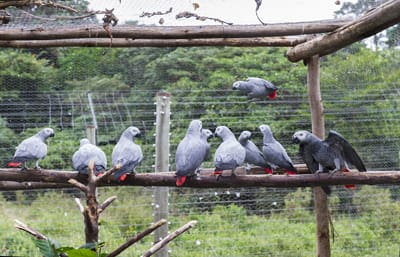Grey Parrots: Confiscation and Rehabilitation
Status:

Collaborators/Funders:
Greenfingers, Pandrillus, LWIRO (Centre de Réhabilitation des Primates de Lwiro), ConservCongo, KAFRED (Kibale Association for Rural and Environmental Development), Limbe Wildlife Centre, Focused Conservation and Nigerian Conservation Foundation, the Nigeria National Park Services and Nigeria Customs Service, Dingi Parrot Conservation Centre (Projet de Protection des Perroquets, Lukuru Foundation), National Environmental Standards and Regulations Enforcement Agency (NESREA)
The WPT has supported the seizure, care and management of hundreds of illegally trafficked Grey Parrots (Psittacus erithacus) in the last two decades. In 2020, for the first time, 39 rehabilitated Greys were released back to the wild in the Democratic Republic of the Congo, with a further 63 released after that. Other groups of Grey Parrots have been intercepted in several countries in an uptick of heightened awareness and local collaboration.
In 2022, 120 Grey Parrots were intercepted from a wildlife trafficker in Uganda. Thanks to the concerted efforts of various organizations, the parrots found refuge at the Uganda Wildlife Education Centre where they began rehabilitation. In June 2023, the first group of 58 rehabilitated parrots was successfully relocated to a release aviary in Kibale National Park. Further, WPT mobilised the care and transport of Grey Parrots confiscated in Eastern Europe to various zoos and sanctuaries.
The WPT has funded rehabilitation and release aviaries for parrots rescued from trade in the Democratic Republic of Congo, Liberia, Senegal, Guinea and Sierra Leone. Training workshops in best practice protocols for caring for rescued parrots are being provided in Angola and Cameroon.
As of late, Nigeria has become a prominent participant in the global illegal wildlife trade, serving as an important source, destination and transit point. The World Wildlife Seizures database highlights that, over the past decade, the country has consistently held a position among the top five countries globally in both source and destination categories for seized shipments. Despite the intricate nature of this situation, there is a concerted effort among various organisations to disrupt the wildlife trade in Nigeria. In 2022, the government of Nigeria published a new National Strategy to Combat Wildlife and Forest Crime – an important step forward opening the door to much-needed actions.
The WPT teamed up with the P3M project in 2023 to establish the Dingi Parrot Rescue Centre near Kindu in central Democratic Republic of Congo, a key hotspot in the trade in Grey Parrots. The facility has received over 200 parrots, many of which have been returned to the wild. Crucially, the centre has hosted meetings with Provincial authorities that prompted the announcement of a decree, which has now been replicated in two neighbouring provinces, banning the capture and trade of Grey Parrots.
IUCN/CITES Status: Endangered / Appendix I
Population: As few as 560,000, decreasing.
Range: Grey Parrots are found in S Nigeria, S Central African Republic, Republic of Congo, DRC, Gabon, Equatorial Guinea, SE Ivory Coast, N Angola, S Democratic Republic of Congo, NW Tanzania, W Kenya, W Uganda, Principe and Bioko Islands.
Natural history: Seen in primary and secondary rainforest, clearings, mangroves, wooded savanna, cultivated land and gardens to an altitude of 2200 m (7216 ft). Diet includes fruits and seeds, particularly oil palm fruit. Flocks roost in palms over water or on islands in rivers. Breeding is January-February and June-July, E Africa; in other areas the dry season. Nest is a cavity in a tall living tree.
